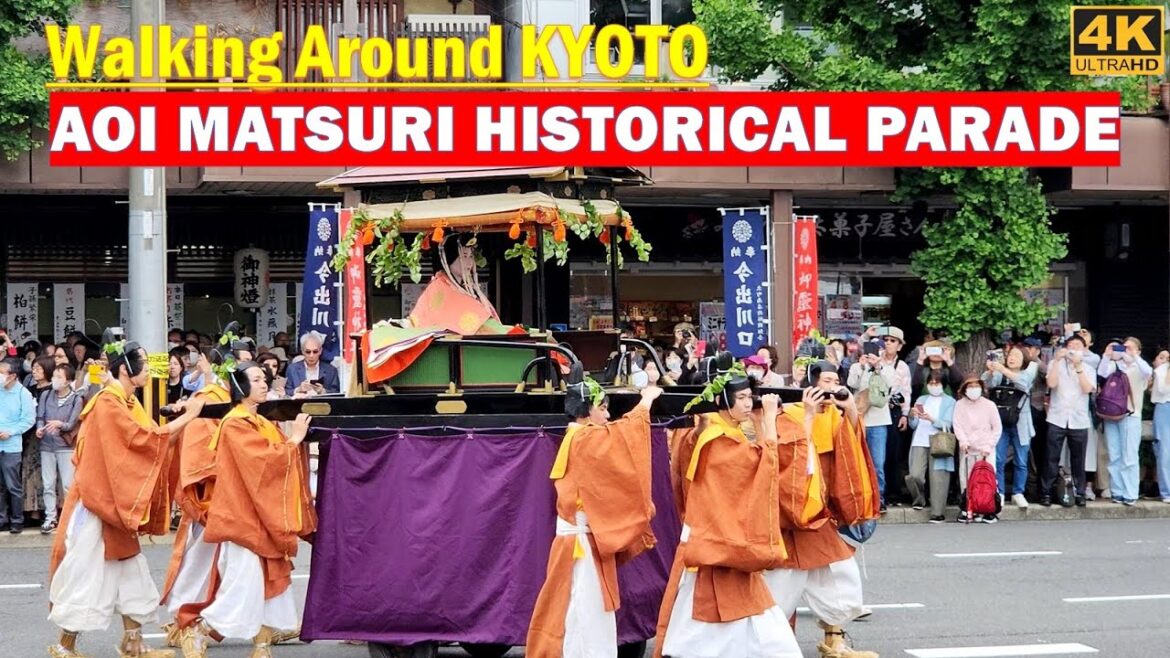Shimogamo Shrine location : https://maps.app.goo.gl/CQtAG5fqbof8htLw5
What happens at Aoi Matsuri?
The festival’s main event is a procession of 500 people in the intricate aristocratic costumes of the Heian period (794-1185). Hollyhock leaves, a symbol of protection from natural disaster, are worn by the procession. The parade is truly a sight to behold.
The festival was created as a ritualized petition to the shrine deities for the safety and wellbeing of the state and its people. Aoi Matsuri culminates in a procession held on May 15, just as the fresh growth of spring plants reaches its peak.
Why is Matsuri so important?
What is Matsuri (Japanese cultural festival)? – Japan Travel …
Japan is full of charm in each region and each season. Traditionally Japanese people have long believed that there are eight million gods that reside in everything. Matsuri are held to express gratitude to nature and the gods, to enjoy life, and to foster community.
Where can I watch the Aoi Matsuri?
You can view the procession anywhere on the route. But the best place to view the parade is the Imperial Palace and Shimogamo shrine. They have reserved seat (2000 yen) for spectators. It takes about an hour to watch the entire procession passing through.
What do people wear during the Aoi Matsuri procession?
ikansokutai
The procession held during the Aoi Matsuri features people dressed in the most formal wear of the time, called ikansokutai, and the ceremonial robes of Japanese court ladies, known as junihitoe. The highlight of the procession is the elegant atmosphere of the greenery in the unforgettable Tadasu-no-mori forest.
===
Kyoto (/ˈkjoʊtoʊ/;[3] Japanese: 京都, Kyōto [kʲoꜜːto] ⓘ), officially Kyoto City (京都市, Kyōto-shi, [kʲoːtoꜜɕi] ⓘ), is the capital city of Kyoto Prefecture in the Kansai region of Japan’s largest and most populous island of Honshu. As of 2020, the city had a population of 1.46 million, making it the ninth-most populous city in Japan. More than half (56.8%) of Kyoto Prefecture’s population resides in the city. The city is the cultural anchor of the substantially larger Greater Kyoto, a metropolitan statistical area (MSA) home to a census-estimated 3.8 million people. It is also part of the even larger Keihanshin metropolitan area, along with Osaka and Kobe.
Kyoto is one of the oldest municipalities in Japan, having been chosen in 794 as the new seat of Japan’s imperial court by Emperor Kanmu. The original city, named Heian-kyō, was arranged in accordance with traditional Chinese feng shui following the model of the ancient Chinese capitals of Chang’an and Luoyang. The emperors of Japan ruled from Kyoto in the following eleven centuries until 1869. It was the scene of several key events of the Muromachi period, Sengoku period, and the Boshin War, such as the Ōnin War, the Honnō-ji Incident, the Kinmon incident, and the Battle of Toba–Fushimi. The capital was relocated from Kyoto to Tokyo after the Meiji Restoration. The modern municipality of Kyoto was established in 1889. The city was spared from large-scale destruction during World War II and, as a result, its prewar cultural heritage has mostly been preserved.
Kyoto is considered the cultural capital of Japan and is a major tourist destination. The agency for cultural affairs of the national government is headquartered in the city. It is home to numerous Buddhist temples, Shinto shrines, palaces and gardens, some of which have been designated collectively as a World Heritage Site by UNESCO. Prominent landmarks include the Kyoto Imperial Palace, Kiyomizu-dera, Kinkaku-ji, Ginkaku-ji, and Kyoto Tower. The internationally renowned video game company Nintendo is based in Kyoto. Kyoto is also a center of higher learning in the country, and its institutions include Kyoto University, the second-oldest university in Japan.
Name
In Japanese, Kyoto was previously called Kyō (京), Miyako (都), Kyō no Miyako (京の都), and Keishi (京師). After becoming the capital of Japan at the start of the Heian period (794–1185), the city was often referred to as Heian-kyō (平安京, “Heian capital”), and late in the Heian period the city came to be widely referred to simply as “Kyōto” (京都, “capital city”). After the seat of the emperor was moved to the city of Edo and that city was renamed “Tōkyō” (東京, meaning “eastern capital”), Kyoto was briefly known as “Saikyō” (西京, meaning “western capital”). As the capital of Japan from 794 to 1868, Kyoto is sometimes called the thousand-year capital (千年の都).
Historically, foreign spellings for the city’s name have included Kioto and Miaco or Meaco.
https://en.wikipedia.org/wiki/Kyoto
===
#walkingaround #kyoto #kyotosightseeing #japanexplorer #japan #japanvirtualtour #japan4k #japanvlog #walkingaroundindonesia #jepang


8 Comments
Ff
Hi bg ❤❤❤❤😊😊😊 walking 0:01
Sore ada lagi 🙏🙏 walking around 👊🤗🤗👍👍👍❤❤❤❤❤❤❤
Excellent video 😊🤗✨✨
😂😂😂😂😂
Hadir bang ikutan jln-jln di Jepangnya lagi,wah mantap bang seru banget nonton paradenya😊👍
Ollaaa Sir Walkin2 Around!! Nihon no Omoshiroi Omatsuri. Have You ever See Gion Matsuri, Nebuta Matsuri, Tenjin Matsuri & Awa Odori?? Enjoy the Asia Festival. Getsumatsu Matsuri o Tanoshimou Yay!!! 🎎🎐🎏🎑🧧🎍
Japan is one of the beautiful countries and super clean